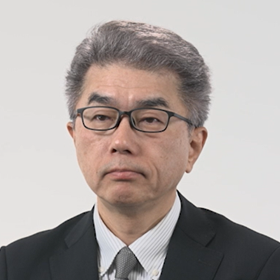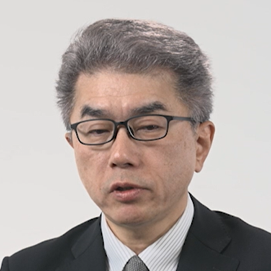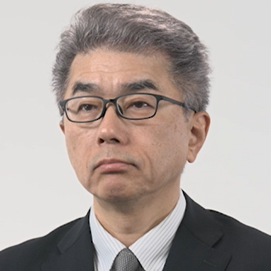Key person interview

We hope to use this knowledge to advance clinical development
Masaaki Hasama
Question 1. Regarding the collaborative research with SymBio Pharmaceuticals, what results were achieved in 2023?
Last year, there was a lot of progress in our collaborative research, and we obtained various results that were presented at academic conferences.
In a joint study with Dr. Jason Y. Chan of the National Cancer Centre Singapore, the antitumor activity of brincidofovir against NK/T-cell lymphoma was confirmed, and in 2023, a new biomarker* for its effectiveness was discovered. These results were presented by Dr. Jason Y. Chan at the International Conference on Malignant Lymphoma (ICML) held in Lugano, Switzerland in June 2023. In the presentation at the conference, it was revealed that there are several cell lines with different responsiveness to brincidofovir, and by comprehensively analyzing the gene expression of these cell lines, a gene called TLE1 was discovered. This gene was originally known as a tumor suppressor gene, and has the function of suppressing tumors. It has been found that the lower the expression of this gene, the stronger the antitumor effect of brincidofovir. An interesting thing about TLE1 is that it was found to be a prognostic factor that predicts a poor prognosis for patients, which we also announced. However, we also discovered the potential for brincidofovir to become a new treatment option for patients with low TLE1 expression and a poor prognosis, and we believe that being able to announce this at the conference is an achievement.
Meanwhile, in a joint study with Dr. Jacobson of the National Institute of Neurological Disorders and Stroke (NINDS) under the National Institutes of Health (NIH), the effects of brincidofovir brincidofovir the proliferation of EBV in lymphocytes at very low concentrations, and also inhibits lymphocyte proliferation itself. No such effect was observed against control lymphomas that were negative for the virus, but it was found that proliferation was inhibited against virus-positive lymphocytes. Dr. Jacobson's team presented this at the Multiple Sclerosis Society (ECTRIMS-ACTRIMS Joint Conference) held in Milan, Italy in October 2023.
I believe that last year was a year in which the results of this collaborative research were announced publicly and led to achievements such as patent applications to secure intellectual property rights.
*Biomarker: A substance in the body, such as a protein or gene, that serves as an indicator of changes in the condition or the effectiveness of treatment.
Question 2: You have a collaborative research project with University of California San Francisco (UCSF). What prompted you to start this project? What results have you achieved so far?
The trigger goes back quite a long way, but even before SymBio introduced brincidofovir, it was reported that cytomegalovirus was associated with the malignant progression of glioblastoma (highly malignant brain tumor). We were interested in tumors related to such viruses, and since glioblastoma in particular is a disease with a very high unmet medical need, we had been discussing among the relevant parties even before the introduction that brincidofovir could be used for treatment. After the introduction, when we were thinking of conducting joint research somewhere, Dr. Ozawa of UCSF reported on the effect of cidofovir (not approved in Japan) on glioblastoma, so we approached Dr. Ozawa to ask about testing brincidofovir.
Dr. Ozawa also became very interested in this, and tests on human tumor xenograft mouse models began immediately. The effects of brincidofovir on glioblastoma are being investigated, and we are beginning to see some good results.
Question 3: When communicating with collaborative research partners, what points about brincidofovir do you mention?

There are three specific points about the characteristics of brincidofovir. First, it has a structure in which a fatty chain is attached to cidofovir, a previously known antiviral drug, and it is a drug that has been greatly improved in two aspects: intracellular uptake and safety. Second, it has excellent effectiveness against a wide range of double-stranded DNA viruses, so it may be applicable to diseases related to each virus. Third, it has been shown to have an effect on tumors in addition to its antiviral effect, which is expanding the range of applications.
Question 4: On the other hand, what is it about brincidofovir that interests people who are considering collaborations or partnerships with you?
Because it is originally known as an antiviral drug, people's first reaction to hearing that it also has antitumor effects is to be unable to imagine what the mechanism is, so we take the approach of explaining the mechanism of action, helping people understand that even though it is an antiviral drug, it also has antitumor effects, and thereby pique their interest.
Question 5. In May 2023, POC * was achieved in the adenovirus testing, but have there been any changes in negotiations or communication with collaborative research partners and business partners?

When I requested an interview, I was often met immediately. In particular, regarding the POC for adenovirus, I can imagine it being approved and becoming a product in the future, so I think there is an advantage in being able to have a concrete discussion about that.
*POC (Proof-of-Concept): POC refers to the process of verifying the efficacy of a new drug conceived during the research stage through actual preclinical study and clinical trials.
Question 6. What are your goals for 2024 as CSO or Director of Translational Research?
One of our goals in the translational research department's role in the development of brincidofovir is to steadily fulfill the roles of the non-clinical aspects, clinical pharmacology, and virus analysis, and we hope to contribute to the promotion of clinical development.
Additionally, with regard to joint research, we are already seeing some results, and we would like to take these results into account in concrete terms, such as filing patent applications and publicly announcing them.
In my role as CSO, I would like to keep a close eye on all aspects related to science and ensure that we maintain the quality of SymBio.
Question 7. What are your goals for the next five or six years, towards 2030?
In terms of goals, or what I would like to achieve, I believe that by 2030, we will likely see results from the various clinical trials and preclinical study that we are currently working on, and we can expect to see not only a development pipeline, but also a product pipeline and product lineup.
Question 8: Finally, please give a message to our shareholders.
I personally believe that SymBio Pharmaceuticals is taking on a very challenging challenge, but the reason for this is that brincidofovir has a lot of potential. The entire company is now working on approaches and efforts to bring out that potential. In the future, these efforts should bear fruit or become products, so I hope you will understand this.
